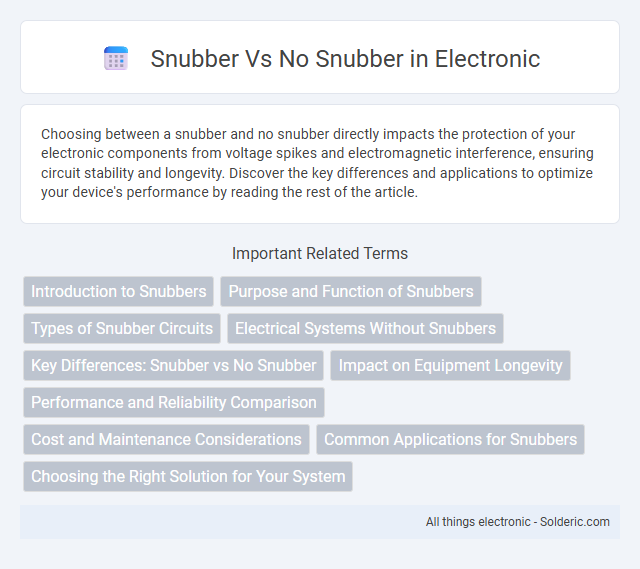Choosing between a snubber and no snubber directly impacts the protection of your electronic components from voltage spikes and electromagnetic interference, ensuring circuit stability and longevity. Discover the key differences and applications to optimize your device's performance by reading the rest of the article.
Comparison Table
| Feature | Snubber | No Snubber |
|---|---|---|
| Purpose | Reduces voltage spikes and protects components | No voltage spike suppression |
| Component Protection | Prevents damage to switches and transistors | Higher risk of component failure |
| Signal Integrity | Improves signal stability | Possible signal distortion and noise |
| Cost | Additional component cost | Lower initial cost |
| Complexity | Adds circuit design complexity | Simpler circuit design |
| Energy Loss | Minor energy loss due to snubber components | No additional energy loss |
| Application | Recommended in inductive load switching and PWM circuits | Suitable for non-inductive or low-risk circuits |
Introduction to Snubbers
Snubbers are essential electrical components designed to suppress voltage spikes and transients in circuits, protecting sensitive devices from damage and extending their lifespan. Without a snubber, your electronic systems are more vulnerable to sudden voltage surges caused by inductive loads or switching operations, which can lead to malfunction or failure. Implementing the right snubber enhances reliability, reduces electromagnetic interference, and improves overall circuit performance.
Purpose and Function of Snubbers
Snubbers are designed to protect electrical circuits by absorbing voltage spikes and limiting transient currents, thereby preventing damage to sensitive components. Without a snubber, your circuit is more susceptible to voltage overshoot and stress, which can cause premature failure or erratic operation. The primary function of a snubber is to improve circuit reliability and extend the lifespan of electronic devices by dissipating excess energy safely.
Types of Snubber Circuits
Snubber circuits are essential in protecting power electronics by controlling voltage spikes and reducing electromagnetic interference, with main types including RC snubbers, RL snubbers, and diode snubbers. RC snubbers, composed of resistors and capacitors, are widely used to suppress voltage transients across switching devices like MOSFETs and IGBTs. RL snubbers utilize resistors and inductors to manage current surges, while diode snubbers, such as flyback or freewheeling diodes, provide a path for inductive load energy, preventing damaging voltage spikes.
Electrical Systems Without Snubbers
Electrical systems without snubbers often experience higher voltage spikes and increased electromagnetic interference, leading to reduced component lifespan and potential circuit damage. Without the protective damping effect of a snubber circuit, switching devices like transistors and relays face greater stress, which can result in erratic operation or failure. Ensuring your electrical system includes an appropriate snubber design helps mitigate these risks and enhances overall reliability and performance.
Key Differences: Snubber vs No Snubber
Snubbers protect electrical circuits by dissipating voltage spikes, reducing stress on components and enhancing system reliability, while circuits without snubbers are more susceptible to transient voltage damage and electromagnetic interference. Using a snubber circuit results in smoother voltage and current waveforms, which lowers the risk of component failure and improves switching performance. In contrast, circuits without snubbers often experience higher switching losses and increased electromagnetic noise, potentially leading to decreased efficiency and shortened device lifespan.
Impact on Equipment Longevity
Using a snubber significantly enhances equipment longevity by reducing voltage spikes and absorbing transient energy, which prevents stress on sensitive components like transistors and diodes. Without a snubber, electrical devices are more susceptible to premature failure due to repeated exposure to high-frequency voltage spikes and ringing effects. Your equipment's reliability and lifespan improve when a properly designed snubber circuit is integrated into the system, safeguarding against potential damage caused by switching transients.
Performance and Reliability Comparison
Using a snubber circuit significantly enhances performance by reducing voltage spikes and oscillations, which improves the overall stability of power electronic devices. Without a snubber, devices are prone to increased electromagnetic interference (EMI) and thermal stress, leading to higher failure rates and reduced lifespan. Reliability is markedly improved with snubbers, as they protect switching components and mitigate transient voltage damage in circuits such as power converters and motor drives.
Cost and Maintenance Considerations
Choosing a snubber circuit increases initial cost due to extra components but often reduces long-term maintenance expenses by protecting equipment from voltage spikes and prolonging the lifespan of devices. In contrast, opting for no snubber lowers upfront costs but can lead to higher repair and replacement costs from increased stress on electrical components. Your decision should weigh the trade-off between initial investment and potential savings on maintenance over time.
Common Applications for Snubbers
Snubbers are widely used in power electronics to protect semiconductor devices such as transistors and diodes from voltage spikes caused by inductive loads in applications like motor drives, inverters, and switching power supplies. They effectively reduce electromagnetic interference (EMI) and enhance switching reliability by absorbing transient energy and suppressing voltage overshoot. In contrast, circuits without snubbers risk device failure and increased electromagnetic noise, especially in high-speed switching environments.
Choosing the Right Solution for Your System
Choosing between a snubber and no snubber depends on your system's voltage spike characteristics and switching speed requirements. A snubber circuit protects components by absorbing transient voltage spikes, enhancing system reliability and longevity. Evaluating your system's switching behavior and transient conditions ensures you select the most effective solution for optimal performance.
Snubber vs No snubber Infographic

 solderic.com
solderic.com